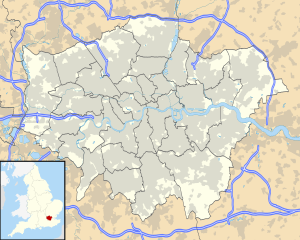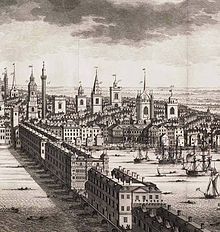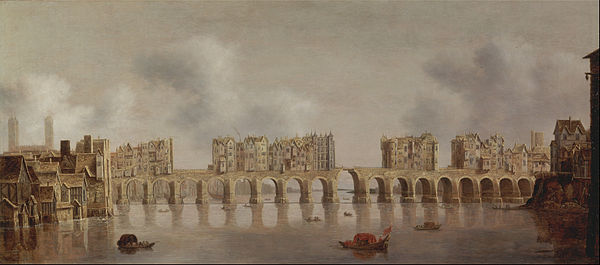London Bridge
Coordinates: 51 ° 30 ′ 29 ″ N , 0 ° 5 ′ 16 ″ W.
| London Bridge | ||
|---|---|---|
| London Bridge at dusk | ||
| use | Motor vehicles A3 , pedestrians Formerly: wagons |
|
| Crossing of | Thames | |
| place | London | |
| Entertained by | Owned by Bridge House Estates. Maintenance: Greater London Authority |
|
| construction | Historic bridge: wood Old bridge: arch , drawbridge New bridge: arch bridge Modern bridge: concrete arch bridge |
|
| overall length | Old bridge: 273 m New bridge: 283 m Modern bridge: 283 m |
|
| width | Old bridge: 6 m New bridge: 15 later 20 m Modern bridge: 32 m |
|
| Longest span | Modern bridge: 104 m | |
| height | Modern bridge: 9 m | |
| building-costs | New bridge: £ 2 million Modern bridge: £ 4 million |
|
| start of building | Old Bridge: 1176 New Bridge: 1824 Modern Bridge: 1967 |
|
| completion | Old Bridge: 1209 New Bridge: 1831 Modern Bridge: 1972 |
|
| opening | New bridge: August 1, 1831 Modern bridge: March 17, 1973 |
|
| planner | New bridge: John Rennie sen. Modern bridge: Mowlem engineering office |
|
| closure | Historic bridge: 1136 Old bridge: 1831 New bridge: 1968 |
|
| location | ||
|
|
||
The London Bridge is a road bridge , which over the River Thames in London leads. It connects the City of London on the north side with the district of Southwark in the London Borough of Southwark on the south side. On the southern shore are the Southwark Cathedral and London Bridge Station , on the north bank, the Monument of the Great Fire of London .
Until the opening of Westminster Bridge in 1750, the (old) London Bridge was the only bridge over the Thames in today's city center. The current bridge is 283 m long, 32 m wide and consists of three prestressed concrete girders. The six-lane main road A3 leads over it . London Bridge is owned by Bridge House Estates , a City of London Corporation charity ; however, maintenance is provided by the Greater London Authority .
history
A bridge over the Thames has existed at almost the same point for about 2000 years. The first was built by the Romans around AD 46 and was made of wood. After the Romans left, the bridge fell into disrepair, but it was probably repaired or rebuilt several times. In 1014 it was burned down on the orders of King Aethelred in order to split the attacking troops of the Dane Sven Gabelbart into several groups. This event probably provided the inspiration for the famous children's song London Bridge is Falling Down . The bridge that was subsequently built was destroyed by a storm in 1091 and again by a fire in 1136.
Old London Bridge
After the destruction in 1136, the clergyman in charge of maintenance, Peter de Colechurch, suggested replacing the wooden bridge with a more permanent stone structure. Construction of the bridge began in 1176 during the reign of Henry II , under the supervision of Peter de Colechurch. The stone bridge piers were placed on stone-filled ovals; the ovals rested on foundations of logs rammed into the river floor and were surrounded by breakwaters to protect them from being washed out by the enormous tide . That was a novel process at the time. After 33 years, four years after de Colechurch's death in 1205, the building was opened in 1209 during the reign of King Johann Ohneland . The medieval bridge consisted of 19 small, irregular pointed arches and a larger passage with a drawbridge , the bridge was six meters wide and 273 m long. Its distinctive building segments were the city-side north gate ( New Stone Gate ) above the second pillar, the drawbridge gate with the guardhouse on each side on the seventh pillar. The latter was first erected as a wooden gate with double towers (1209), and in 1426 as a stone double gate with four integrated round corner towers. There was also a chapel on the eleventh, larger pillar with a crypt accessible from the river (served as the grave of its builder Peter de Colechurch), which was consecrated to Thomas Becket and renewed in 1384-1397. The south gate ( Great Stone Gateway or Great Stone Gate ), similar to the drawbridge gate , was at the Southwark end of the bridge. King Johann had the idea to build houses on the bridge for rent. Soon thereafter, shops and residential buildings were built. Contemporary images show the bridge with houses up to seven stories high. The number of inhabitants was so high that the bridge was considered a separate city district with its own district council until the 18th century. In 1381 the Wat Tyler uprising was suppressed on the bridge, and in 1390 a joust was held.
Due to the small size of the arches and the breakwaters on the pillar bases, 80 percent of the river's course was dammed. This created a level difference of around two meters between both sides of the bridge and the resulting strong currents and eddies. The current was used to operate water wheels under the outer arches of the bridge. In 1582, Peter Morris built two huge waterwheels under the northern arch to operate water pumps to supply London with tap water from the Thames for the first time, with permission from the city council . Two more water wheels were later installed under the second arch. In 1591 two water wheels were installed at the south end to operate grain mills . Because of the rapid current and narrow passage, it was considered dangerous and difficult to steer a boat without scratching or colliding with the breakwaters under the bridge, which was called "shooting the bridge"; many drowned, which is why passengers upstream at "The Three Cranes" disembarked and downstream at Billingsgate boarded the boat again. A proverb said at the time that the bridge was “for wise men to pass over, and for fools to pass under”. Several bridge arches collapsed over time. Houses were burned down during the Peasants' Revolt of 1381 and the Jack Cade Rebellion of 1450.
The northern gate, the New Stone Gate , a massive double tower gate towering over the bridge, was integrated into the houses over time. The Zugbrückentor, a still larger, rectangular, provided with integrated in the four corners round towers Doppeltorbau served to 1577 under the nickname Traitor's Gate ( Verrätertor ), before the called Tower so, in addition, the exhibition of the plugged on wooden sticks and skewers heads and other parts of the body of convicted traitors. It was replaced in 1577 under Elizabeth I by the Nonsuch House ( house with many windows ) in the style of the other houses as a half-timbered building, a gate construction with four corner towers, and the drawbridge by a solid wooden bridge. The special thing about this house construction was that it was made entirely of wood without metal nails and was constructed in Flanders, transported to London in building segments and assembled and installed on the bridge with wooden dowels. At the behest of Elizabeth I, the southern gate (the Great Stone Gateway ) with its unobstructed, free-standing front became the Traitor's Gate , the most notorious sight in London. The heads of traitors have been exhibited since 1305 under the reign of Edward I, initially on the drawbridge gate, usually speared on wooden poles and tarred to protect against faster decomposition, so that every Londoner could see them. The first head on display was that of the Scottish national hero William Wallace . A tradition that lasted more than 350 years developed from this. This custom was not until 1660 at the behest of King Charles II. After his reinstatement to an end because it heads too much of the execution of his father Charles I remembered. The last head to be planted on the south gate belonged to William Stayley, a goldsmith convicted of treason. He had made death threats against the king, was sentenced to death, quartered and beheaded. His body parts and head, which had already been buried at the request of the family, were exhumed by order of the king because of the very provocative burial and distributed on the gates and London Bridge (head). Other famous heads on poles were those of Wat Tyler (1381), Jack Cade (1450), Thomas More , whose head was stolen from there by his daughter, and Bishop John Fisher (1535), Thomas Cromwell, 1st Earl of Essex ( 1540) and Guy Fawkes (1606) and his fellow conspirators. A German traveler counted over thirty heads on the bridge in 1595.
The buildings on the bridge posed a major fire hazard. In the year 1212 or 1213 a devastating fire broke out at the north and south end at the same time, which shut in the people. There are said to have been more than 3,000 deaths at that time. Another fire destroyed the northern third in 1633. However, this meant that the Great Fire of 1666 did not spread to the bridge, as this part had since been replaced by a stone structure.
By 1722 the traffic on the bridge became so rampant that the Lord Mayor issued the following order: All wagons and carts that were traveling from Southwark towards the city were to drive on the west side of the bridge and all vehicles that left the city, on the east side. That was possibly the origin of left-hand traffic in England . In 1725 a fire destroyed the buildings at the south end with the south gate, which was torn down in 1727. In 1756 the law was passed for the complete demolition of all buildings. Between 1758 and 1762 all the houses were demolished (1757 the Nonesuchhaus, 1761 the north gate) and the two central arches were replaced by a single arch to facilitate navigation on the river.
New London Bridge
At the end of the 18th century, the now 600 year old London Bridge had to be renewed. It was narrow, dilapidated and an obstacle to river navigation . In a competition in 1799, Thomas Telford won the contract to build a bridge from a single iron arch 180 meters long. The plan was revolutionary and sensational at the time, but was never implemented because the feasibility was not guaranteed and the space required for construction was not available.
The bridge was eventually replaced with a new five-arch stone bridge. John Rennie Sr. supplied the design . The new bridge was built 30 meters upstream from the old one and cost £ 2 million (£ 202 million in today's purchasing power). The construction was completed in seven years by John Rennie jun. , the son of the architect, completed between 1824 and 1831. The old bridge was still in operation during construction, but was then demolished.
Rennie's bridge was made of Dartmoor granite, was 283 meters long and 15 meters wide. The opening by King William IV and Queen Adelaide took place on August 1, 1831. The royal couple attended a banquet held in a makeshift pavilion on the bridge. The recently built HMS Beagle was the first ship to pass under the bridge. In order to capture the opening properly, the king had previously commissioned the painter Clarkson Stanfield , who was well known at the time and was also highly valued by the king for his artistic work, to capture the moment of the opening in an oil painting. The painting Opening of New London Bridge was completed in 1832 and exhibited at the Royal Academy of Arts . It is still in the royal collection today.
It is estimated that around 1896 the bridge was used by 8,000 pedestrians and 9,000 vehicles per hour. The bridge was then widened from 16 to 20 meters between 1902 and 1904 in order to cope with the increasing volume of traffic. However, the weight exceeded the load-bearing capacity of the foundations and it was found in retrospect that it decreased by an inch every eight years. In 1924 the east side was three to four inches deeper than the west side.

On April 18, 1968, American entrepreneur Robert McCulloch bought the bridge for $ 2.46 million (today's purchasing power is $ 18 million). It was removed stone by stone and some of it was shipped to Lake Havasu City , Arizona . There, the building material was used to clad a concrete bridge (→ London Bridge (Lake Havasu City) ). The remaining building materials were shipped to the Merryvale quarry in Dartmoor in Devon . The bridge has been crossing a canal on Lake Havasu that was later flooded since October 10, 1971, and is the second most important tourist attraction in Arizona after the Grand Canyon .
Modern London Bridge
Today's London Bridge was built by the John Mowlem construction company between 1967 and 1972 and opened by Queen Elizabeth II on March 17, 1973 . It consists of three prestressed concrete girders, is 283 meters long and 32 meters wide. The construction costs were around 4 million British pounds (53 million pounds in today's purchasing power). It is exactly where Rennie's bridge was. During the construction, Rennie's bridge was dismantled piece by piece.
In 1984 the warship HMS Jupiter collided with the bridge and caused considerable property damage; the bridge had to be renewed.
On June 3, 2017 and November 29, 2019 , the bridge was the scene of Islamist- motivated terrorist attacks .
Below the bridge, on the south side of the Thames, is now the tourist attraction The London Bridge Experience .
Nursery rhyme
There is a well-known nursery rhyme about the lack of maintenance of London Bridge : " London Bridge is Falling Down ".
literature
- Peter Jackson: London Bridge - A Visual History . Historical Publications, 2002. ISBN 0-948667-82-6 .
- Peter Murray, Mary Anne Stevens: Living Bridges - The inhabited bridge, past, present and future . Royal Academy of Arts, London 1996. ISBN 3-7913-1734-2 .
- Patricia Pierce: Old London Bridge - The Story of the Longest Inhabited Bridge in Europe . Headline Books, 2001. ISBN 0-7472-3493-0 .
Web links
- London Bridge. In: Structurae
- The London Bridge Experience
- London Bridge Museum
- Image of the Nonesuch House
- Pictures of the model bridge
Individual evidence
- ^ Rev. John Ray: Book of Proverbs . London 1670; quoted in: Peter Jackson: London Bridge , p. 77
- ^ Dunton, Larkin (1896). The World and Its People. Silver, Burdett.
- ↑ Dismissed terrorists become an election issue. The daily mirror of November 30, 2019
|
Upstream Cannon Street Railway Bridge |
River crossings of the Thames |
Downstream tunnel of the Northern Line Tower Subway |










